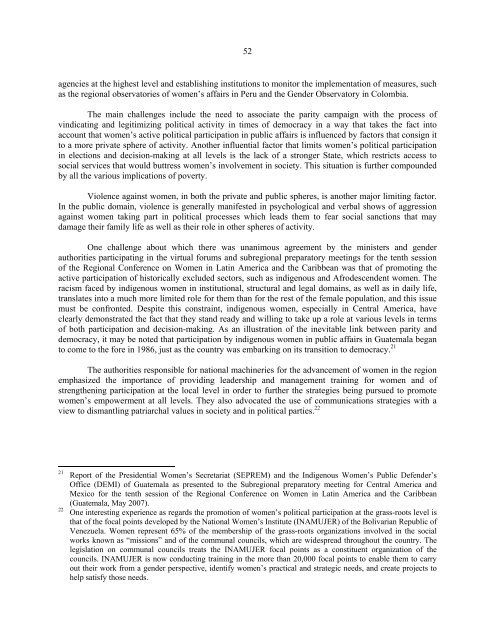Women in Latin America and the Caribbean - Cepal
Women in Latin America and the Caribbean - Cepal
Women in Latin America and the Caribbean - Cepal
You also want an ePaper? Increase the reach of your titles
YUMPU automatically turns print PDFs into web optimized ePapers that Google loves.
52<br />
agencies at <strong>the</strong> highest level <strong>and</strong> establish<strong>in</strong>g <strong>in</strong>stitutions to monitor <strong>the</strong> implementation of measures, such<br />
as <strong>the</strong> regional observatories of women’s affairs <strong>in</strong> Peru <strong>and</strong> <strong>the</strong> Gender Observatory <strong>in</strong> Colombia.<br />
The ma<strong>in</strong> challenges <strong>in</strong>clude <strong>the</strong> need to associate <strong>the</strong> parity campaign with <strong>the</strong> process of<br />
v<strong>in</strong>dicat<strong>in</strong>g <strong>and</strong> legitimiz<strong>in</strong>g political activity <strong>in</strong> times of democracy <strong>in</strong> a way that takes <strong>the</strong> fact <strong>in</strong>to<br />
account that women’s active political participation <strong>in</strong> public affairs is <strong>in</strong>fluenced by factors that consign it<br />
to a more private sphere of activity. Ano<strong>the</strong>r <strong>in</strong>fluential factor that limits women’s political participation<br />
<strong>in</strong> elections <strong>and</strong> decision-mak<strong>in</strong>g at all levels is <strong>the</strong> lack of a stronger State, which restricts access to<br />
social services that would buttress women’s <strong>in</strong>volvement <strong>in</strong> society. This situation is fur<strong>the</strong>r compounded<br />
by all <strong>the</strong> various implications of poverty.<br />
Violence aga<strong>in</strong>st women, <strong>in</strong> both <strong>the</strong> private <strong>and</strong> public spheres, is ano<strong>the</strong>r major limit<strong>in</strong>g factor.<br />
In <strong>the</strong> public doma<strong>in</strong>, violence is generally manifested <strong>in</strong> psychological <strong>and</strong> verbal shows of aggression<br />
aga<strong>in</strong>st women tak<strong>in</strong>g part <strong>in</strong> political processes which leads <strong>the</strong>m to fear social sanctions that may<br />
damage <strong>the</strong>ir family life as well as <strong>the</strong>ir role <strong>in</strong> o<strong>the</strong>r spheres of activity.<br />
One challenge about which <strong>the</strong>re was unanimous agreement by <strong>the</strong> m<strong>in</strong>isters <strong>and</strong> gender<br />
authorities participat<strong>in</strong>g <strong>in</strong> <strong>the</strong> virtual forums <strong>and</strong> subregional preparatory meet<strong>in</strong>gs for <strong>the</strong> tenth session<br />
of <strong>the</strong> Regional Conference on <strong>Women</strong> <strong>in</strong> Lat<strong>in</strong> <strong>America</strong> <strong>and</strong> <strong>the</strong> <strong>Caribbean</strong> was that of promot<strong>in</strong>g <strong>the</strong><br />
active participation of historically excluded sectors, such as <strong>in</strong>digenous <strong>and</strong> Afrodescendent women. The<br />
racism faced by <strong>in</strong>digenous women <strong>in</strong> <strong>in</strong>stitutional, structural <strong>and</strong> legal doma<strong>in</strong>s, as well as <strong>in</strong> daily life,<br />
translates <strong>in</strong>to a much more limited role for <strong>the</strong>m than for <strong>the</strong> rest of <strong>the</strong> female population, <strong>and</strong> this issue<br />
must be confronted. Despite this constra<strong>in</strong>t, <strong>in</strong>digenous women, especially <strong>in</strong> Central <strong>America</strong>, have<br />
clearly demonstrated <strong>the</strong> fact that <strong>the</strong>y st<strong>and</strong> ready <strong>and</strong> will<strong>in</strong>g to take up a role at various levels <strong>in</strong> terms<br />
of both participation <strong>and</strong> decision-mak<strong>in</strong>g. As an illustration of <strong>the</strong> <strong>in</strong>evitable l<strong>in</strong>k between parity <strong>and</strong><br />
democracy, it may be noted that participation by <strong>in</strong>digenous women <strong>in</strong> public affairs <strong>in</strong> Guatemala began<br />
to come to <strong>the</strong> fore <strong>in</strong> 1986, just as <strong>the</strong> country was embark<strong>in</strong>g on its transition to democracy. 21<br />
The authorities responsible for national mach<strong>in</strong>eries for <strong>the</strong> advancement of women <strong>in</strong> <strong>the</strong> region<br />
emphasized <strong>the</strong> importance of provid<strong>in</strong>g leadership <strong>and</strong> management tra<strong>in</strong><strong>in</strong>g for women <strong>and</strong> of<br />
streng<strong>the</strong>n<strong>in</strong>g participation at <strong>the</strong> local level <strong>in</strong> order to fur<strong>the</strong>r <strong>the</strong> strategies be<strong>in</strong>g pursued to promote<br />
women’s empowerment at all levels. They also advocated <strong>the</strong> use of communications strategies with a<br />
view to dismantl<strong>in</strong>g patriarchal values <strong>in</strong> society <strong>and</strong> <strong>in</strong> political parties. 22<br />
21<br />
22<br />
Report of <strong>the</strong> Presidential <strong>Women</strong>’s Secretariat (SEPREM) <strong>and</strong> <strong>the</strong> Indigenous <strong>Women</strong>’s Public Defender’s<br />
Office (DEMI) of Guatemala as presented to <strong>the</strong> Subregional preparatory meet<strong>in</strong>g for Central <strong>America</strong> <strong>and</strong><br />
Mexico for <strong>the</strong> tenth session of <strong>the</strong> Regional Conference on <strong>Women</strong> <strong>in</strong> Lat<strong>in</strong> <strong>America</strong> <strong>and</strong> <strong>the</strong> <strong>Caribbean</strong><br />
(Guatemala, May 2007).<br />
One <strong>in</strong>terest<strong>in</strong>g experience as regards <strong>the</strong> promotion of women’s political participation at <strong>the</strong> grass-roots level is<br />
that of <strong>the</strong> focal po<strong>in</strong>ts developed by <strong>the</strong> National <strong>Women</strong>’s Institute (INAMUJER) of <strong>the</strong> Bolivarian Republic of<br />
Venezuela. <strong>Women</strong> represent 65% of <strong>the</strong> membership of <strong>the</strong> grass-roots organizations <strong>in</strong>volved <strong>in</strong> <strong>the</strong> social<br />
works known as “missions” <strong>and</strong> of <strong>the</strong> communal councils, which are widespread throughout <strong>the</strong> country. The<br />
legislation on communal councils treats <strong>the</strong> INAMUJER focal po<strong>in</strong>ts as a constituent organization of <strong>the</strong><br />
councils. INAMUJER is now conduct<strong>in</strong>g tra<strong>in</strong><strong>in</strong>g <strong>in</strong> <strong>the</strong> more than 20,000 focal po<strong>in</strong>ts to enable <strong>the</strong>m to carry<br />
out <strong>the</strong>ir work from a gender perspective, identify women’s practical <strong>and</strong> strategic needs, <strong>and</strong> create projects to<br />
help satisfy those needs.











